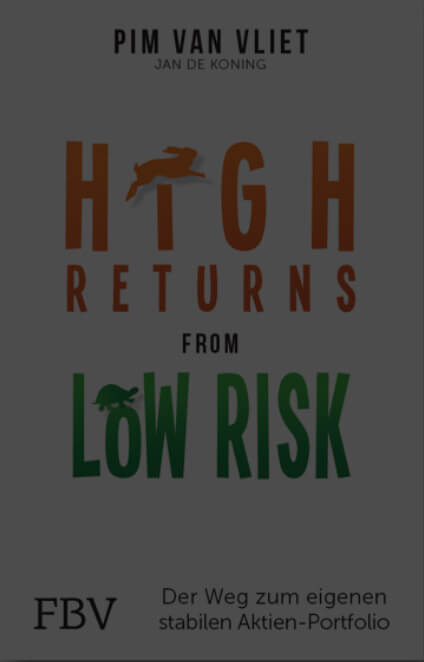Denken Sie einfach an die folgende »Anlegerweisheit«: Je mehr Risiko Sie eingehen, desto höher werden Ihre Renditen sein. Die meisten Aktienanleger, ob professionelle Vermögensverwalter wie Anlageberater und Hedgefonds-Manager oder »do it yourself«-Privatanleger, glauben an dieses Konzept von mehr Risiko, mehr Rendite. Aber stimmt es wirklich?
Im letzten Beitrag ging es um das Buch „High Returns From Low Risk“ von Pim van Vliet. Das Buch scheint zu polarisieren. Wie geht der Autor mit Skeptikern um? Ist die Strategie nicht ein bisschen zu einfach? Und was sagt Vliet zu anderen Strategien? Glücklicherweise kam der Autor meiner Interviewanfrage nach. Viel Spaß beim lesen!
Zum Autor

Pim van Vliet, PhD
(Source: Robeco) Dr. Pim van Vliet is a Senior Portfolio Manager within the Quantitative Equities team of Robeco. His primary responsibility is Robeco’s Conservative Equity strategies.
Pim joined Robeco in 2005 as a Senior Quantitative Researcher with responsibility for asset allocation research. He has published in the Journal of Banking and Finance, Management Science, the Journal of Portfolio Management and other academic journals. He is a guest lecturer at several universities and advocates low-volatility investing at international seminars. He is the author of a number of academic research papers and a book on the topic of low-volatility investing. Pim holds a PhD and MSc (cum laude) in Financial and Business Economics from Erasmus University Rotterdam.
Interview
Congratulations on your book. How much time did the elaboration take? How long did the process take from the idea to the release?
Almost one and a half year between the moment Jan presented me the idea of writing a book about the paradox of high returns from low risk and the moment the book was available for distribution.
It is also a summary of the story on low-risk investing we have been telling since 2006.
„Be Skeptical“ is always a credo in your book. Did you encounter skeptics and resistance in your environment when you presented your paradox?
Yes, that is something that we have been encountering for many years and I believe this is good. People have been educated on (renowed) universities, colleges, CFA courses and so on that there is a positive relation between risk and return: take more risk and there will be a high reward. If you tell people that in reality the opposite holds, it’s normal that people respond skeptical. Back in the days when Bob Haugen – the American professor that also shows up in the book – discovered the negative relation between risk and return (more risk = lower return), he also encountered a lot of skeptism and resistance. And even today, when I present the academic proof delivered by my colleagues, myself or other academics in the field of emperical finance towards an audience of let’s say investment advisors or investors, people sometimes find it difficult to accept that the emperical evidence on low-risk investing basically shows the opposite of what they have known for years: more risk doesn’t equal higher returns. Therefore this little book on the paradox of Low Risk investing. My intend was to write in such way that all investors could benefit from this insights in whatever way possible.
In the book, you speak of several indicators for selecting stocks. Behind this approach is not an extremely time-consuming & detailed analysis procedure. Isn’t that a bit too easy?
Simplicity often beats complexity, that is also a paradox! The formula as presented in the book can be enhanced, with regards to risk, income and momentum. For example, for risk a multi-dimensional approach which also includes distress risk is helpful and momentum could be cleaned from style momentum. However, most challanging is to get the implementation right. For example, when do you sell a stock, how many stocks should one hold in portfolio, how to diversify across countries and sectors? So the implementation details matter. In the book we provide some very gentle solutions for those investors. Besides this, we also present mutual funds as easy alternatives for doing this yourself.
What do you think about other approaches? For example the Levermann-strategy?
There are many roads that will lead you to Rome, and that accounts for stable wealth accumulation by selecting the right investment strategy as well. However, eventually it’s not about the road you are taking but the way you experience that journey. An investment strategy needs to fit your personality otherwise you might not have the stamina to stay in there for the longer run. I firmly believe in the power of having a repeatable investment process (a rules based approach) which foundation lies in the emperical evidence of a deep historical dataset spanning many decennia. The roadmap that we present in the book is one, just like there are many other succesfull ones. But in the end it’s all about you and therefore we provide a lot of insights in the behavior that underpins the ‚why‘ of this successfull investment method.
Is the statement „high risk, low return“ always true? If not, where not?
No there are a few excpetions. Across asset classes higher risk gives higher return as you know equities outperform bonds and bonds outperform cash. These example are often used in finance classes. However, within asset classes high risk usually gives low returns.
You mentioned ETFs. Passive investing is becoming more and more interesting. Why should I invest in an actively managed fund?
Not all ETFs are passive and not all mutual funds are passive. All ETFs and Mutual funds we discuss are active since they deviate from the passive market portfolio and involve trading at a regular basis.
There are two main advantages of investing in mutual funds. First, a mutual fund can include income and momentum when selecting low-risk stocks. Second, the positions ETFs track fully transparant indices. When these indices are tracked by many investors, then if these indices are rebalancing and the rebalancing procedure and stocks that will enter and exit that index are known, othere investors can basically act ahead of the passive or naive investor and already position themselves.An actively managed fund does not have this problem and could even profit from this.
What book(s) are you reading at the moment?
Every good endeavour by Tim Keller. Interesting philosophical book on the role of work in your personal life which I’m reading together with some business friends.
A few final thoughts and tips about investment that you want to share with my readers and me?
Remember that taking on more risk usually does not give you addititional return. A little bit of risk is often enough.
Many Thanks!
Direkt zum Buch:*

